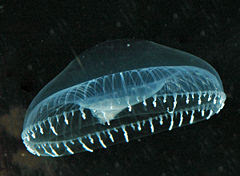In 1988 if you had told most scientists that the human genome would be sequenced within 20 years, and that the resulting genome would turn out to be the least complicated of the –omes, most of them (including this one) would have said that you had been reading too much science fiction.
I distinctly remember discussions in graduate school about how the human genome probably contained around 150,000 genes. As the years progressed, techniques improved and research continued ... and the size of the human genome began to collapse quickly. At one point I remember hearing a colleague comment on how humans appeared to be "de-evolving" at a record pace! By the year 2000 the human genome had shrunk to around 50,000 genes, and over the next eight years it continued to contract. Recent estimates place the number of genes at around 24,000–30,000.
What had happened was not some major evolutionary genomic constriction event; rather, it was a greater understanding of how genes interacted and were processed by the metabolic machinery of the cell. Scientists began to think that it was not the genes themselves that were important; it might be the gene products that truly mattered.
For many molecular biologists, and probably most of the biotechnology community, the genome turned out to be somewhat of a bust. A disease is a phenotype, an outward portrayal of a trait, which in the case of most diseases has an underlying cause in the genome, but not in all cases. Creutzfeldt-Jakob disease is a nice example of a condition that is caused not by a defect in a gene (although there is some suggestion of genetic susceptibility), but rather by a malfunctioning protein called a prion. In fact, most diseases are caused by protein-related problems. Thus, in order to understand human disease it was necessary to take a good look at the proteome, or the sum of the proteins within a cell.
The size of the proteome appears to be even more elusive than the size of the genome. Estimates range from between 90,000 to more than 400,000 proteins in the human proteome. Of course this number is dependent on a number of items, including cell type, influence of external stimuli, cell age, nutritional state, etc. The proteome is the cell's response to its environment, and therefore it is expected that it will fluctuate depending on the needs of the cell.
So while some still work to identify the entire proteome, attention has shifted to what the proteome can tell us about the health of a cell. To do that, it was necessary to understand interactions within the proteome. This is called the interactome and it encompasses the study of all interactions at the molecular level within cells. The interactome is based primarily on protein-protein interactions. This led to amazing breakthroughs in systems biology, which integrated biochemistry, molecular genetics and cell biology to more fully understand how cells work.
Something very interesting occurred at this point. When studying protein interactions it is often useful to go back and identify the genes that code for each protein. Advances in biotech have made this a relatively easy process, and it was only a matter of time before scientists began to uncover some intriguing connections. In a New York Times article by Andrew Pollack, the author interviews scientists who have used studies of the proteome and interactome to reveal genes common to both heart attacks and muscular dystrophy — two seemingly unrelated conditions.
In other words, molecular science has come full circle. An understanding of the genome is once again important, but so is an understanding of the interactome and proteome. Together, these items are sometimes called the diseasome. The diseasome represents the latest evolution of the -ome; it fully integrates all information to understand factors that may cause a disease.
If you are having a hard time visualizing the diseasome, then a quick visit to an interactive graphic on a portion of the diseasome prepared by The New York Times will help immensely. If you notice, there are connections in this diagram that seem to be impossible if you think only about the disease, such as genes linking myocardial infarctions and Alzheimer's disease. But if you step back from the disease for a second, and integrate the information, it starts to make sense. At the cellular level, metabolic activities are directed by genes and proteins interacting in complex manners. Since there are a limited number of genes and proteins, but a seemingly unlimited number of diseases, then there must be common factors that we have previously missed.
So what does all of this mean? The ability to visualize these interactions may allow medical researchers to develop innovative methods of detecting and treating disease states. Some, such as Dr. Albert-László Barabási at The New England Journal of Medicine and Northeastern University, have called this network medicine.
In the very near future, as more of these interactions are mapped out, doctors may begin to prescribe unique combinations of drugs that would have not even been considered 10, or even five, years ago.
Diseases that previously were thought to be too complex to cure, such as muscular dystrophy and diabetes, may very soon be things of the past.
Note: this article first appeared in the June 5, 2008 issue of BioWorld Perspectives, and is reproduced here by permission of AHC Media, LLC











.jpg)
